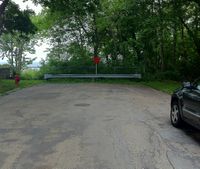Tag:noexit=yes
 |
| Description |
|---|
| Confirms that the endpoint of a highway is a dead end with no possibility to travel further by any transport mode along a formal path or route. |
| Group: properties |
| Used on these elements |
| Status: de facto |
| Tools for this tag |
|
Use the noexit=yes tag at the end of a highway=* to indicate that there is no possibility to travel further by any transport mode along a formal path or route. The tag noexit=yes is mainly useful where a road or path ends close to another way but where it isn't possible to get through due to a barrier or other obstruction, which may otherwise look like a mistake for a connection to the nearby road. It helps other mappers and quality-check programs to understand the situation correctly.
For this tag it does not matter, if there is a dead-end sign at the beginning of the street or not. If you want to tag traffic signs, use traffic_sign=*.
Note: this tag is by no means an access restriction (indicating that passing is not allowed). It must be ignored by routing (GPS). Its purpose is to either confirm a way ends when this way has limited visibility on satellite imagery (e.g. blocked by trees), or to inform quality assurance software or a human reader that an otherwise suspicious tag or road layout preventing passing further than the end of a road is perfectly intentional (more usage instructions).
Usage
Use the noexit=yes tag only on the very last node ![]() at the end of a
at the end of a highway=* or on the last way ![]() to indicate when doubtful that the impossibility to travel further by any transport mode is perfectly normal, due to otherwise existing road layout.
to indicate when doubtful that the impossibility to travel further by any transport mode is perfectly normal, due to otherwise existing road layout.
If applicable, add highway=turning_circle or highway=turning_loop.
Note that this tag is only used by any tool when it's tagged on a node ![]() .
.
When not to use
This tag should not be used when the way is only a dead-end for one transport mode, but where other modes can continue. By way of example don't use it at the end of a motorised road where a footpath continues.
It's also not a substitute for the tag barrier=* when the road is stopped by a barrier or wall.
Alternatives
In cases where an obstacle like a guard rail or a wall is blocking the passage, it is recommended that this should be mapped.
If you wish to indicate that a way does continue but that you have been unable to map it for some reason use fixme=continue (or any other text) to show that a way goes further but is not mapped yet. This may often be a very short stub from a road indicating the start of a path or side road.
Data users
Rendering
If tagged on nodes, this tag is rendered on OSMC Reitkarte (a topographic hiking and bridle map) and in the JOSM editor, as the german dead-end sign.
![]()
- View in OSM Transport Karte:

Validators
- Osmose will not flag a way as an "almost junction" (error 1270) if there is a
noexit=yestag on the node. - JOSM will not flag a way as an "almost junction" if there is a
noexit=yestag on the node.
See also
access=*- Access-Restrictions
nonsquare=*used by iD to mark a building as non-square